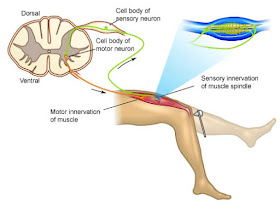What is a reflex? If you ask 10 different people, there is a good chance you will get 10 different answers. Many different and imperfect definitions of reflexes exist. For example, if the car in front of you suddenly stops, and you quickly step on the brake, is that a reflex? Well, if we go by the textbook definition of a reflex, which is an involuntary muscle contraction or coordinated patterns of muscle contraction and relaxation elicited by a specific stimuli, it is not a reflex. You have a choice of whether or not to press the brake pedal (sometimes people don't and rear end the car in front of them). Reflexes are involuntary movements that are very difficult or almost impossible to override.
There are many different types of reflexes. One of the simplest and most familiar is the Tendon (T) tap reflex. Everyone has had this reflex tested at one time or another. You sit on the end of the exam table with your knee flexed (bent) at about 90 degrees, and the doctor taps your patellar tendon with a mallet. What should is happen is that after the tap, the knee should extend (straighten). Why does this happen? When the doctor taps the tendon, it activates the muscle spindles, which send signals to the CNS that the muscle (the quadriceps) is lengthening. In order to counteract this lengthening, the CNS will activate the alpha motoneurons of the quadriceps, causing the muscle to shorten in order to counteract the lengthening. The entire process should take around 35 milliseconds (thousandths of a second).
What is the purpose of this reflex? Its functional significance is very small. We aren't walking and moving around often where we get "hit" on a tendon and need a reflexive response. However, this is a fairly easy reflex to elicit, meaning that it is a useful diagnostic tool for a doctor. He or she is making sure the reflex is present, and that there is a normal response, and not an exaggerated or diminished response. This would indicate some type of neurological disorder. We will talk about more complicated reflexes and their significance in the future.

No comments:
Post a Comment